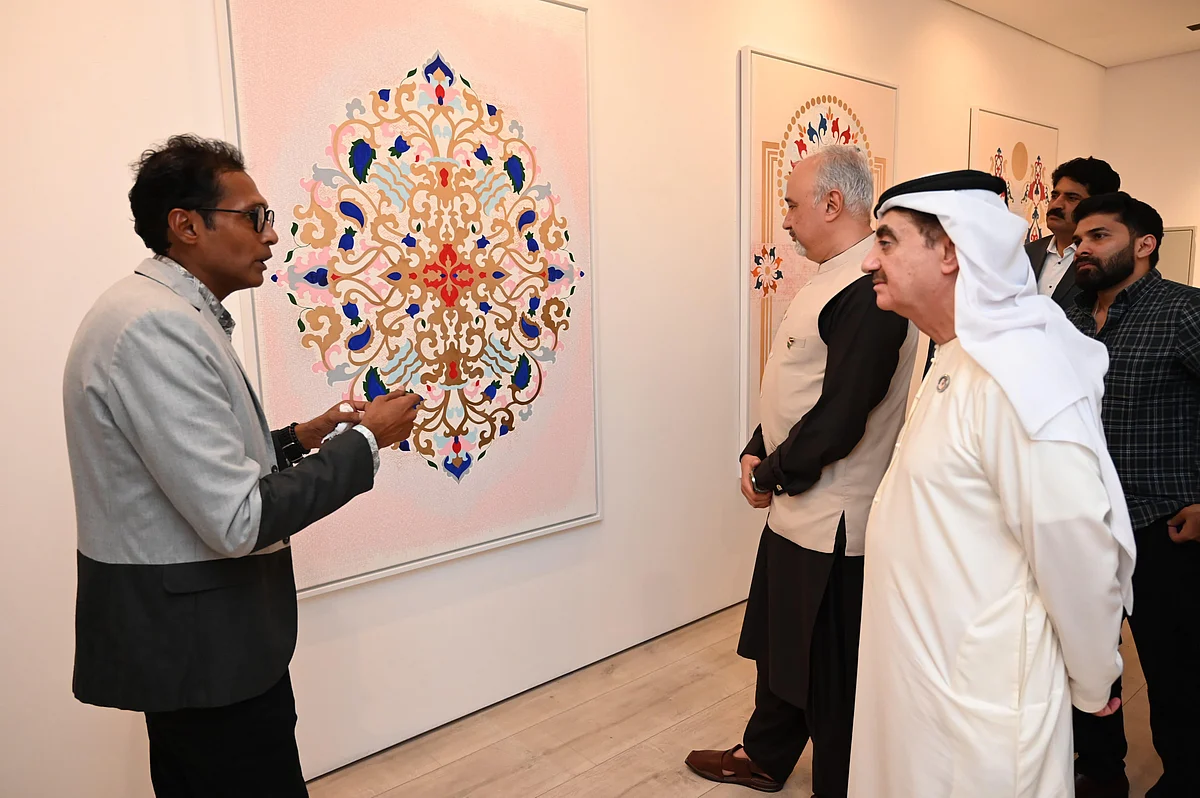
Shahzad Hassan Ghazi Plays With Textures And Time In Solo Dubai Exhibition 'Grace Versus Strength'
To an artist, self-expression is a basic need. And Pakistani creator Shahzad Hassan Ghazi finds he leans towards the abstract to explore perception, to filter meaning from a scene, to ground him in the present.
The artist's work has been showing in Leila Heller Gallery in Dubai's AlSerkal Avenue, where it will run until September 30. For his solo show, titled Grace Versus Strength: The Elements of Ornaments, Ghazi drew from his love of miniature paintings, the hypnotic value of geometric patterns and ancient prints, and contemporised design using a new palette and canvas to showcase creativity.
Recommended For You UAE weather: Alerts issued for fog, rough seas; temperatures to dip to 22oCIn an interview, he explains that while people like the idea of finding meaning in form and colour, which is“a universal language”, abstract art is an expression of feeling;“there really are no rules”.
That said, for his showcase, he drew from the ancient practice of miniature painting.“I trained as a miniature artist,” he says.“We used to have tiny handmade brushes, which we used to make tiny paintings, Mughal miniature art. For it, you need to have the stamina to sit down for six-seven hours at a time. For this show, I kept the same intensity of the craftsmanship in my work, but I changed the scale of it and the imagery...each piece took almost three months to finish, and I worked from nine to five every day.”
In some cases, where he textured a canvas, Ghazi had to first create a smooth plane.“It took me sometimes five days just to prepare the white base of the canvas...you see, a canvas has its own texture. So, I needed to apply a special material and then let it dry and then sand it. Then I had to apply another layer. It could go up to 15 layers, depending on the humidity and the weather at the time.”
For this set of displays, Ghazi explains, his starting point was an older exhibition similarly named Grace versus Strength: The Elements of Ornament.“When I started working on this series, I was talking to Leila Heller about the route my art journey has been taking. She asked me to observe Persian carpets – designs that are famous in Asia.” In doing so, she had offered him a new prism to look through – he dove through catalogues of old design, finding parallels between weaves and time period, between subject and popular culture, between patterns and their evolution.
Then came the interplay of technique and time.“I was used to starting from a miniature brush and going on to a rapido pen, a technical pen usually used by architects and designers. And it's somewhere very much in rooted me these decorative motives and patterns. So, this time, thought, I will try to immerse these two together – classic and modern art.”
His current paintings take from the Iranian palette, using ultra marine turquoise blue and saturated red and gold hues to create visuals of note. In fact, the artist uses real gold and silver leaf in combination with rapido graph pens.
The rapido pens etch pleats into white space, giving the illusion of texture drawn by time; each line crafted measures less than a centimetre.“The patterns in my work are very, very symmetrical and play with the viewer's gaze. The lines are drawn in a way to manipulate the audience's gaze, allowing you to go from one side of a painting to another and, perhaps, beyond. On other canvases, the artist plays ping-pong with the viewer's sight, using composition to keep their attention.”
There is little space for negotiation or to colour outside pre-decided lines, he adds.“I need 100 focus while I draw my lines; it's like a pattern of construction and deconstruction.”
The artist, who was born in 1983, in Lahore, addresses the elephant in the room – what it takes to make a living doing just art at a time rife with artists, both real and artificial intelligence-based.“Artists need to think art as a business at the same time as expression, because it becomes a business when galleries are investing in you, collectors are buying your work, and they want to see you growing....And it's just as important for your craft to experiment with new ideas, with new thoughts, with new subjects, with new materials,” he explains.
And that's exactly what he himself is focused on: Exploring new ideas.“I'm done with this series. The new series is coming with the surprises of universal truths that I normally try to explore in my art practice,” he concludes.

Legal Disclaimer:
MENAFN provides the
information “as is” without warranty of any kind. We do not accept
any responsibility or liability for the accuracy, content, images,
videos, licenses, completeness, legality, or reliability of the information
contained in this article. If you have any complaints or copyright
issues related to this article, kindly contact the provider above.


















Comments
No comment